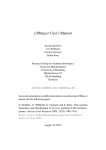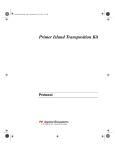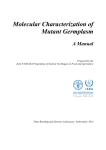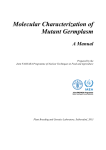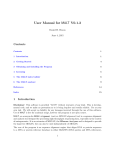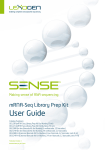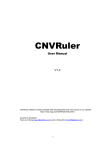Download LTRharvest user`s manual
Transcript
LTRharvest a manual David Ellinghaus Stefan Kurtz Ute Willhoeft Research Group for Genomeinformatics Center for Bioinformatics University of Hamburg Bundesstrasse 43 20146 Hamburg Germany [email protected] In any documentation or publication about research using LTRharvest please cite the following paper: D. Ellinghaus, S. Kurtz, and U. Willhoeft. LTRharvest, an efficient and flexible software for de novo detection of LTR retrotransposons, BMC Bioinformatics 2008, 9:18 http://www.biomedcentral.com/1471-2105/9/18 August 6, 2012 1 Introduction This document describes LTRharvest [1], a software tool for de novo predictions of LTR retrotransposons in genomic sequences [4]. LTRharvest computes boundary positions of potential LTR retrotransposons on a persistent index structure of the genomic target sequence, the enhanced suffix array [3]. Usually the genomic target sequence is a complete chromosomal DNA sequence in FASTA format. Nevertheless, every DNA sequence in (multiple) FASTA format can be passed to the software. For the prediction, LTRharvest implements several filters. These are consecutively applied on the sequence data to reject candidates, which are not conform with sequence, length or distance features of LTR retrotransposons. Since these features are mostly species-specific, every filter can be switched on or switched off and is free for parameterisation of a certain LTR retrotransposon model. LTRharvest is written in C and it is based on the GenomeTools library [5]. LTRharvest is called as part of the single binary named gt. LTRharvest runs on an enhanced suffix array index, which is stored on files. This index needs to be constructed by the program suffixerator, which is also part of the GenomeTools binary gt. 2 Usage Some text is highlighted by different fonts according to the following rules. • Typewriter font is used for the names of software tools. • Small typewriter font is used for file names. • Footnote sized typewriter font with a leading ’-’ is used for program options. • small italic font is used for the argument(s) of an option. 2.1 The options of LTRharvest Since LTRharvest is part of gt, LTRharvest is called as follows. gt ltrharvest -index indexname [options] where indexname denotes the enhanced suffix array index of the target sequence(s) constructed by the program Suffixerator. An overview of all possible options with a short one-line description of each option is given in Table 1. All options can be specified only once. 2.2 Input options -index indexname Specify the name of the enhanced suffix array index. The index must comprise the tables suf, lcp, des and tis. An example of how the enhanced suffix array index is constructed with the program Suffixerator can be found in section 3. 1 Table 1: Overview of the LTRharvest options sorted by categories. Input options -index -range specify the name of the enhanced suffix array index specify the range in the input sequences to be searched for LTR retrotransposon candidates Output options -out -gff3 -outinner specify outputfilename for predictions in multiple FASTA format specify outputfilename for predictions in GFF3 format specify outputfilename for multiple FASTA file of the inner regions of predictions Filter options -seed -minlenltr -maxlenltr -mindistltr -maxdistltr -similar -mintsd -maxtsd -motif -motifmis -vic specify minimum seed length for exact maximal repeats specify minimum length for each LTR specify maximum length for each LTR specify minimum distance of LTR startpositions specify maximum distance of LTR startpositions specify similaritythreshold in range [1..100%] specify minimum length for each TSD specify maximum length for each TSD (requires -mintsd) specify palindromic motif consisting of 2 nucleotides startmotif + 2 nucleotides endmotif, specify maximum number of mismatches in motif (requires -motif) specify the number of nucleotides (to the left and to the right) that will be searched for TSDs and/or motifs around 5’ and 3’ boundary specify no|best|all Alignment options -overlaps -xdrop -mat -mis -ins -del specify xdrop value for seed extension specify matchscore for seed extension specify mismatchscore for seed extension specify insertionscore for seed extension specify deletionscore for seed extension Miscellaneous options -v -longoutput -help verbose mode additional motif/TSD output (requires -mintsd or -motif) show all options 2 The option -index is mandatory. -range x y Specify the range in the input sequence(s) to be searched for LTR retrotransposon candidates. That is, if x = 1000 and y = 10000 then candidates are only reported if they start after position 1000 and end before position 10000 in their respective sequence coordinates. If x = y = 0 (default), then the whole sequences are searched. 2.3 Output options Results are reported in tabular fashion on stdout and can easily be written to a file using the notation > resultfile as in the following: gt ltrharvest -index indexname [options] > resultfile In addition, the following options write extra information to files -out outputfile Specify the name of a file where the predictions will be written to. Each prediction will be represented by an individual FASTA entry. -outinner outputfile Specify the name of a file where the inner regions (the prediction sequences without the flanking LTR sequences) will be written to. Each prediction will be represented by an individual FASTA entry. -gff3 outputfile Specify the name of a file where the predictions will be written to. Each prediction will be represented by an individual GFF3 [2] entry. 2.4 Filter options The filter options provide the opportunity to exclude predictions with unwanted sequence, length or distance features. If a particular option is not set by the user, a default value for this options will be set, except for the options -mintsd, -maxtsd and -motif. Thus, if none of the filter options is set by the user, a prediction of LTR retrotransposons will be conducted without searching for target site duplications (TSD) or a particular LTR start-end motif. -seed Lex Specify the minimum length for the exact maximal repeats. Only those repeats with the specified minimum length are analyzed in the process of finding candidate pairs. Exact maximal repeats of length below that threshold are not taken further into account. Lex has to be a positive integer. If this option is not selected by the user, then Lex is set to 30 by default. -minlenltr Lmin Specify the minimum length of each LTR. Lmin has to be specified as a positive integer. If this option is not selected by the user, then Lmin is set to 100 by default. 3 -maxlenltr Lmax Specify the maximum length of each LTR. Lmax has to be specified as a positive integer. If this option is not selected by the user, then Lmax is set to 1000 by default. -mindistltr Dmin Specify the minimum distance of LTR starting positions. Dmin has to be specified as a positive integer. If this option is not selected by the user, then Dmin is set to 1000 by default. -maxdistltr Dmax Specify the maximum distance of LTR starting positions. Dmax has to be specified as a positive integer. If this option is not selected by the user, then Dmax is set to 15000 by default. -similar similaritythreshold Specify the minimum similarity value between the two LTRs. The argument similaritythreshold has to be chosen from the range [0,100] and means a percentage. If this option is not selected by the user, the default value is set to 85%. -mintsd TSDminlen If this option is selected, a search for target site duplications (TSDs) will be conducted with a minimum TSD length of TSDminlen. If this option is not selected by the user, a search for TSDs with minimum TSD length 4 will be conducted. If this option is set but no maximum TSD length is specified by the option -maxtsd, then the maximum TSD length is set to 20 by default. -maxtsd TSDmaxlen This option requires the option -mintsd. If this option is selected, a search for target site duplications (TSDs) will be conducted with a maximum TSD length of TSDmaxlen. -motif expr Specify 2 nucleotides for the starting motif and 2 nucleotides for the ending motif at the beginning and the ending of each LTR, respectively. Only palindromic motif sequences - where the motif sequence is equal to its complementary sequence read backwards - are allowed, e.g. tgca. Type the nucleotides without any space separating them. If this option is not selected by the user, then candidate pairs will not be checked, if they contain a motif. If this options is set but no allowed number of mismatches is specified by the option -motifmis, then a search for the exact motif will be conducted. -motifmis n This option requires the option -motif. Specify the allowed number of mismatches by the argument n. If this option is not set, then a search for the exact motif will be conducted. The non-negative integer n has to be chosen from the range [0, 3]. -vic l Specify the number of nucleotide positions l to the left and to the right (the vicinity), that will be searched for TSDs and/or one motif around the 5’ and 3’ predicted boundary of a LTR retrotransposon. This option has only an effect, if option -mintsd and/or option -motif is switched on. If this option is not selected by the user, the default value of l is 60. 4 -overlaps no|best|all Specify the output with regard to nested and/or overlapping LTR retrotransposon predictions. If the argument no is selected, then neither nested nor overlapping predictions will be reported in the output. If the argument best is selected, then, in the case of two or more nested or overlapping predictions, solely the LTR retrotransposon prediction with the highest similarity between its LTRs will be reported. If the argument all is selected, then all LTR retrotransposon predictions will be reported whether there are nested and/or overlapping predictions or not. If this option is not selected by the user, the option with argument best is set by default. 2.5 Alignment options An X-drop extension process permits the search for degenerated LTRs. The alignment options provide the opportunity to control this extension of the maximal repeat seeds. If a particular alignment option is not set by the user, a default value for this options will be set. -xdrop X Specify the xdrop value X for extending a seed repeat in both directions allowing for matches, mismatches, insertions, and deletions. The argument X must be a positive integer or 0. The X-drop extension process stops as soon as the extension involving matches, mismatches, insertions, and deletions has a score smaller than T − X where T denotes the largest score seen so far. If this option is not selected by the user, then X is set to 5 by default. -mat score Specify the positive match score for the X-drop extension process. If the option is not selected by the user, the default value is 2. -mis score Specify the negative mismatch score for the X-drop extension process. If this option is not selected by the user, the default value is −2. -ins score Specify the negative insertion score for the X-drop extension process. If this option is not selected by the user, the default value is −3. -del score Specify the negative deletion score for the X-drop extension process. If this option is not selected by the user, the default value is −3. 2.6 Miscellaneous options -v This option enables the verbose mode. This means, that some more information about the processing will be printed to stdout during the run. This includes a long list of switched on or switched off options. 5 -longoutput This option additionally prints information about the detected TSD and/or the motif to stdout, if a search for TSD and/or for the motif has been selected by the user. This option requires the option -mintsd and/or -motif. -help LTRharvest will show a summary of all options on stdout and terminate with exit code 0. 3 Examples In this section, example applications of LTRharvest are presented. In Subsection 3.1, examples for using different options of LTRharvest are given. Subsection 3.2 then gives an example for the prediction of LTR retrotransposons on the entire S. cerevisiae genome. In Subsection 3.3, an example for a clustering process of the LTRharvest output is shown. Please note that this step is not part of LTRharvest and is carried out by Vmatch [7]. 3.1 Using different options of LTRharvest As target sequence file we use some FASTA file chr02.19970727.fsa.gz containing the S. cerevisiae genome sequence, chromosome 2. Note that the file is a compressed file in gzip format (because of the ending .gz). This format can be handled by the program Suffixerator. First, we create the enhanced suffix array. We invoke gt suffixerator with options -tis, -suf, -lcp, -des, -ssp and -sds since LTRharvest needs the corresponding tables. Furthermore, we specify -dna, as we process DNA-sequences. $ gt suffixerator -db chr02.19970727.fsa.gz -indexname chr02.19970727.fsa -tis -suf -lcp -des -ssp -sds -dna # dna=yes # indexname="chr02.19970727.fsa" . . . # TIME overall 1.37 Now we can use the index for LTRharvest. The first example call will just use the default parameters for the filter and alignment options without searching for TSD or an LTR start-end motif. $ gt ltrharvest -index chr02.19970727.fsa # args=-index chr02.19970727.fsa # predictions are reported in the following way # s(ret) e(ret) l(ret) s(lLTR) e(lLTR) l(lLTR) s(rLTR) e(rLTR) l(rLTR) sim(LTRs) seq-nr # where: # s = starting position # e = ending position # l = length # ret = LTR-retrotransposon 6 # lLTR = left LTR # rLTR = right LTR # sim = similarity # seq-nr = sequence number 259532 265448 5917 259532 259863 332 265117 265448 332 99.40 427672 430021 2350 427672 428170 499 429522 430021 500 91.60 29632 35597 5966 29632 29969 338 35259 35597 339 98.82 0 220989 226919 5931 220989 221339 351 226574 226919 346 97.15 0 0 0 Each comment line starts with the comment symbol #. Each non-comment line denotes a LTR retrotransposon prediction with starting and ending positions of the whole LTR retrotransposon, the left LTR instance and the right LTR instance, respectively. Furthermore, for each of these elements, the corresponding element length is reported as well as a percentage similarity of the two LTRs. The last integer of each line denotes the number of the input sequence, the LTR retrotransposon prediction occurs in. The input sequence numbers are counted from 0. Invoking LTRharvest with the optional argument -v gives more information about enabled and disabled options as well as additional information about the enhanced suffix array index and time/space consumption. Moreover, specifying options -out and -outinner the run results in two multiple FASTA files. $ gt ltrharvest -index chr02.19970727.fsa -v -out pred-chr02.fsa -outinner pred-inner-chr02.fsa # args=-index chr02.19970727.fsa -v -out pred-chr02.fsa -outinner pred-inner-chr02.fsa # user defined options and values: # verbosemode: On # indexname: chr02.19970727.fsa # outputfile: pred-chr02.fsa # outputfile inner region: pred-inner-chr02.fsa # xdropbelowscore: 5 # similaritythreshold: 85.00 # minseedlength: 30 # matchscore: 2 # mismatchscore: -2 # insertionscore: -3 # deletionscore: -3 # minLTRlength: 100 # maxLTRlength: 1000 # minLTRdistance: 1000 # maxLTRdistance: 15000 # overlaps: best # minTSDlength: 0 # maxTSDlength: 20 # palindromic motif: # motifmismatchesallowed: 4 # vicinity: 60 nt # predictions are reported in the following way # s(ret) e(ret) l(ret) s(lLTR) e(lLTR) l(lLTR) s(rLTR) e(rLTR) l(rLTR) sim(LTRs) seq-nr # where: # s = starting position # e = ending position # l = length 7 # ret = LTR-retrotransposon # lLTR = left LTR # rLTR = right LTR # sim = similarity # seq-nr = sequence number 259532 265448 5917 259532 259863 332 265117 265448 332 99.40 427672 430021 2350 427672 428170 499 429522 430021 500 91.60 29632 35597 5966 29632 29969 338 35259 35597 339 98.82 0 220989 226919 5931 220989 221339 351 226574 226919 346 97.15 0 0 0 Searching additionally for TSD and a LTR start-end motif we use the options -mintsd, -maxtsd, -motif and -motifmis. $ gt ltrharvest -index chr02.19970727.fsa -mintsd 5 -maxtsd 20 -motif tgca -motifmis 0 # args=-index chr02.19970727.fsa -mintsd 5 -maxtsd 20 -motif tgca -motifmis 0 # predictions are reported in the following way # s(ret) e(ret) l(ret) s(lLTR) e(lLTR) l(lLTR) s(rLTR) e(rLTR) l(rLTR) sim(LTRs) seq-nr # where: # s = starting position # e = ending position # l = length # ret = LTR-retrotransposon # lLTR = left LTR # rLTR = right LTR # sim = similarity # seq-nr = sequence number 259532 265448 5917 259532 259863 332 265117 265448 332 99.40 0 29632 35590 5959 29632 29963 332 35259 35590 332 99.70 0 220996 226911 5916 220996 221329 334 226575 226911 337 97.33 0 Finally, if we are interested in the sequence and the length of the TSD as well as the sequence of the motif, we select the option -longoutput. This also is an example for specifying all filter and alignment options by the user. $ gt ltrharvest -index chr02.19970727.fsa -seed 30 -xdrop 5 -mat 2 -mis -2 -ins -3 -del -3 -minlenltr 100 -maxlenltr 1000 -mindistltr 1000 -maxdistltr 15000 -similar 90.0 -overlaps all -mintsd 5 -maxtsd 20 -motif tgca -motifmis 0 -vic 60 -longoutput # args=-index chr02.19970727.fsa -seed 30 -xdrop 5 -mat 2 -mis -2 -ins -3 -del -3 -minlenltr 100 -maxlenltr 1000 -mindistltr 1000 -maxdistltr 15000 -similar 90.0 -overlaps all -mintsd 5 -maxtsd 20 -motif tgca -motifmis 0 -vic 60 -longoutput # predictions are reported in the following way # s(ret) e(ret) l(ret) s(lLTR) e(lLTR) l(lLTR) TSD l(TSD) m(lLTR) s(rLTR) e(rLTR) l(rLTR) TSD l(TSD) m(rLTR) sim(LTRs) seq-nr # where: # s = starting position # e = ending position # l = length # m = motif # ret = LTR-retrotransposon # lLTR = left LTR 8 # rLTR = right LTR # TSD = target site duplication # sim = similarity # seq-nr = sequence number 259532 265448 5917 259532 259863 332 gtaat 5 tg..ca 265117 265448 332 gtaat 5 tg..ca 99.40 0 29632 35590 5959 29632 29963 332 ataat 5 tg..ca 35259 35590 332 ataat 5 tg..ca 99.70 0 220996 226911 5916 220996 221329 334 ggaat 5 tg..ca 226575 226911 337 ggaat 5 tg..ca 97.33 0 3.2 Predictions on the entire S.cerevisiae genome As target sequences file we use some multiple FASTA file chrAll.19971001.fsa.gz, which contains all 16 chromosomal sequences of the release before Oct. 1st, 1997, probably used by Kim et al. in their comprehensive survey of retrotransposons [6]. First, we create the enhanced suffix array. We invoke gt suffixerator with options -tis, -suf, -lcp, -des, since LTRharvest needs the corresponding tables. Furthermore, we specify option -dna, as we are processing DNA sequences. $ gt suffixerator -db chrAll.19971001.fsa.gz -indexname chrAll.19971001.fsa -tis -suf -lcp -des -sds -dna # dna=yes # indexname="chrAll.19971001.fsa" . . . # TIME overall 108.35 Now we can use the index with LTRharvest. In addition to the filter and alignment options, we choose option -out for printing the predicted LTR retrotransposon sequences to a file. $ gt ltrharvest -index chrAll.19971001.fsa -seed 100 -minlenltr 100 -maxlenltr 1000 -mindistltr 1000 -maxdistltr 15000 -xdrop 5 -mat 2 -mis -2 -ins -3 -del -3 -similar 90.0 -overlaps best -mintsd 5 -maxtsd 20 -motif tgca -motifmis 0 -vic 60 -longoutput -out pred-chrAll.fsa # args=-index chrAll.19971001.fsa -seed 100 -minlenltr 100 -maxlenltr 1000 -mindistltr 1000 -maxdistltr 15000 -xdrop 5 -mat 2 -mis -2 -ins -3 -del -3 -similar 90.0 -overlaps best -mintsd 5 -maxtsd 20 -motif tgca -motifmis 0 -vic 60 -longoutput -out pred-chrAll.fsa # predictions are reported in the following way # s(ret) e(ret) l(ret) s(lLTR) e(lLTR) l(lLTR) TSD l(TSD) m(lLTR) s(rLTR) e(rLTR) l(rLTR) TSD l(TSD) m(rLTR) sim(LTRs) seq-nr # where: 160239 166163 5925 160239 160575 337 ggttc 5 tg..ca 165827 166163 337 ggttc 5 tg..ca 100.00 0 29632 35590 5959 29632 29963 332 ataat 5 tg..ca 35259 35590 332 ataat 5 tg..ca 99.70 1 . . 9 . 844407 850335 5929 844407 844744 338 gaaat 5 tg..ca 849998 850335 gaaat 5 tg..ca 100.00 15 56452 62375 5924 56452 56788 337 gttat 5 tg..ca 62039 62375 337 gttat 5 tg..ca 100.00 15 3.3 338 Sequence clustering of LTRharvest output (optional) In addition to the prediction process done by LTRharvest, a cluster analysis on the predicted sequences is recommended. Here, we choose the single linkage cluster analysis program from the Vmatch software tool [7] (which is not part of the GenomeTools binary gt) in order to show how this task can be accomplished. An index needs to be constructed from the predicted sequences by the program mkvtree which is part of Vmatch. $ mkvtree -db pred-chrAll.fsa -dna -pl -allout -v reading file "pred-chrAll.fsa" ... . . . overall space peak: main=2.61 MB (10.01 bytes/symbol), secondary=0.53 MB Now we can use vmatch (which is part of Vmatch) to perform a clustering of the predicted sequences. A reasonable parameter set is given in Tab. 2, page 11. See the Vmatch manual [7] for an explanation of the options. The following command computes clusters of all (database) sequences in pred-chrAll.fsa. Each cluster has a unique cluster number, followed by the sequence number contained in the cluster. $ vmatch -dbcluster 95 7 Cluster-pred-chrAll -p -d -seedlength 50 -l 1101 -exdrop 9 pred-chrAll.fsa # args=-dbcluster 95 7 Cluster-pred-chrAll -p -d -seedlength 50 -l 1101 -exdrop 9 pred-chrAll.fsa # 3 clusters # 45 elements out of 46 (97.83%) are in clusters # 1 elements out of 46 (2.17%) are singlets # 1 cluster of size 2 # 1 cluster of size 3 # 1 cluster of size 40 0: 32 41 42 36 39 13 40 43 37 30 44 38 18 21 17 34 35 31 12 20 33 23 26 27 6 28 3 29 25 1 24 9 19 2 7 22 4 10 5 0 1: 8 15 11 2: 14 45 References [1] http://www.zbh.uni-hamburg.de/ltrharvest [2] GFF3, tab delimited file format for sequenceontology.org/gff3.shtml. 10 genome annotation. http://www. Table 2: A default parameter set for Vmatch’s single linkage clustering program. Parameter name dbcluster d p seedlength l exdrop Value Dmin 95 (b( D × 100)c + 1) max 50 Dmin + Lmin 9 Comment Match covers at least 95% of the smaller sequence and (formula value)% of the larger sequence Compute direct matches Compute palindromic matches Minimal length of the exact repeats Minimal length of matches Xdrop score when extending a seed in both directions [3] M.I. Abouelhoda, S. Kurtz, and E. Ohlebusch. Replacing suffix trees with enhanced suffix arrays. Journal of Discrete Algorithms, 2:53–86, 2004. [4] D. Ellinghaus, S. Kurtz, and U. Willhoeft. LTRharvest, an efficient and flexible software for de novo detection of LTR retrotransposons. BMC Bioinformatics, 9:18, 2008. [5] G. Gremme. The G ENOME T OOLS genome analysis system. http://genometools.org. [6] J.M. Kim, S. Vanguri, J.D. Boeke, A. Gabriel, and D.F. Voytas. Transposable elements and genome organisation: a comprehensive survey of retrotransposons revealed by the complete Saccharomyces cerevisiae genome sequence. Genome Research, 8(5):464–478, 1998. [7] S. Kurtz. The V MATCH large scale sequence analysis software. http://www.vmatch.de. 11













